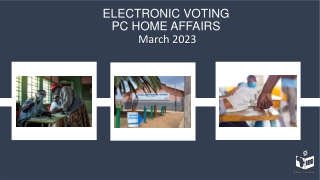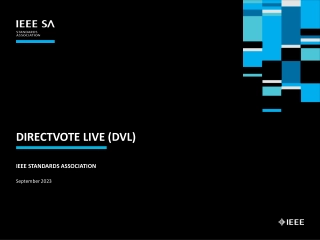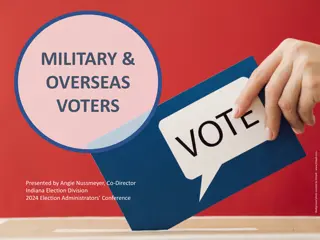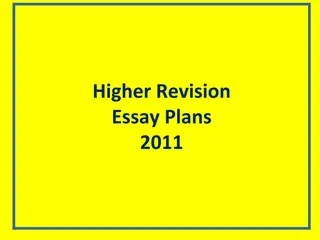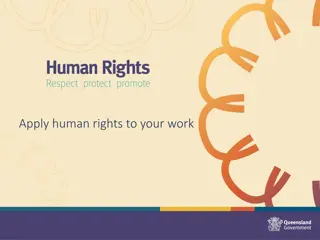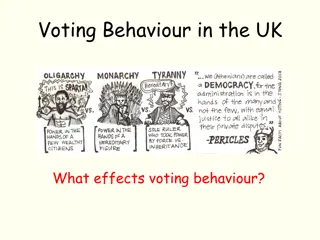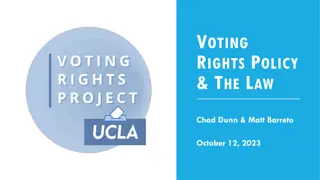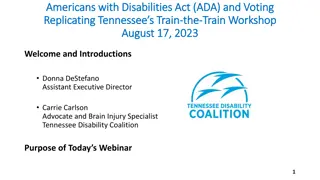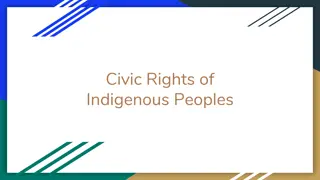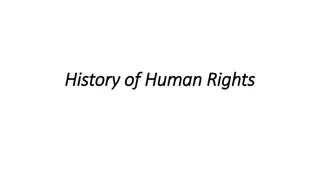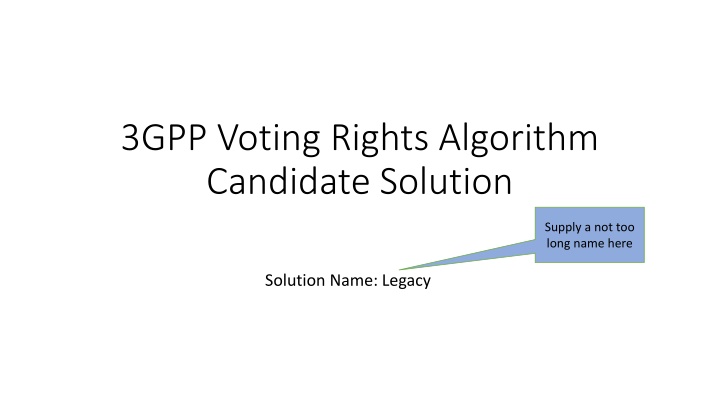
Legacy Voting Rights Algorithm Evaluation Scenarios
Explore the evaluation scenarios of a voting rights algorithm, including advantages and disadvantages, with testing criteria based on different meeting scenarios. Learn how quickly individuals can gain or lose voting rights under various conditions.
Download Presentation

Please find below an Image/Link to download the presentation.
The content on the website is provided AS IS for your information and personal use only. It may not be sold, licensed, or shared on other websites without obtaining consent from the author. If you encounter any issues during the download, it is possible that the publisher has removed the file from their server.
You are allowed to download the files provided on this website for personal or commercial use, subject to the condition that they are used lawfully. All files are the property of their respective owners.
The content on the website is provided AS IS for your information and personal use only. It may not be sold, licensed, or shared on other websites without obtaining consent from the author.
E N D
Presentation Transcript
3GPP Voting Rights Algorithm Candidate Solution Supply a not too long name here Solution Name: Legacy
Description of the Algorithm Describe the algorithm Use the existing voting rights algorithm described in the WP section 35. However, it applies to both f2f and e-meetings.
Advantages/Disadvantages List advantages/disadvantages of the algorithm Advantage: Simple Advantage: Minimal IT impact Advantage: Transition is simple Disadvantage: In the majority of cases, IMs can gain voting rights by only attending e-meetings (and not attending f2f meetings) Disadvantage: In the majority of cases, IMs can maintain voting rights by only attending e-meetings (and not attending f2f meetings)
Evaluation Scenarios The algorithm is tested for how well it does with respect to: 1. How fast can an IM gain rights 2. How fast can an IM gain rights through only e-meetings 3. How fast will an IM lose rights if only attending e-meetings 4. How fast will an IM lose rights if they stop attending anything Each of these tests are performed on a hypothetical set of meeting scenarios a. EEEEEEEEEEEE - All e-meetings b. EFEEEFEEEFEE Mostly e-meetings c. EFEFEFEFEFEF Alternating d. FEFFEFFEFFEF Supplemental e-meetings e. EFFFEFFFEFFF Mostly f2f f. FFFFFFFFFFFF All f2f
Example Evaluation of a Scenario How fast can an IM gain Rights in the alternating e-meetings/f2f where only e-meetings are attended: (Example from Legacy algorithm) Green Highlight = attended, no highlight=missed E=E-Meeting F=f2f Gains or Loses of voting rights are shown with arrows. If the algorithm consists of both old and add-on parts, you can optionally indicate which part triggered the event using colored arrows. Old Gain c. alternating: EFEFEFEFEFEF Place arrow at meeting where rights are gained/lost Note that rights are gained at the beginning of a meeting. Rights are lost after the end of a meeting. Year Boundary Add-on Both Loss
Eval 1: How fast can an IM gain rights (assume no rights or history initially and that the IM attends every meeting) EEEEEEEEEEEE a. All e-meetings: Please position the arrows appropriately for the proposed algorithm EFEEEFEEEFEE b. Mostly e-meetings : EFEFEFEFEFEF c. Alternating: E = attended e-meeting E= missed e-meeting F = attended f2f F = missed f2f FEFFEFFEFFEF d. Supplemental e-meetings: EFFFEFFFEFFF e. Mostly f2f: FFFFFFFFFFFF f. All f2f:
Eval 2: How fast can an IM gain rights through only e-meetings (assume no rights or history initially and that the IM only attends e-meetings) EEEEEEEEEEEE a. All e-meetings: Please position the arrows appropriately for the proposed algorithm EFEEEFEEEFEE b. Mostly e-meetings : EFEFEFEFEFEF c. Alternating: E = attended e-meeting E= missed e-meeting F = attended f2f F = missed f2f FEFFEFFEFFEF d. Supplemental e-meetings: EFFFEFFFEFFF Never gains voting rights e. Mostly f2f: FFFFFFFFFFFF Never gains voting rights f. All f2f:
Eval 3: How fast will an IM lose rights if only attending e-meetings (assume no history initially and that the IM only attends e-meetings) Please position the arrows appropriately for the proposed algorithm EEEEEEEEEEEE Never loses voting rights a. All e-meetings: EFEEEFEEEFEE Never loses voting rights b. Mostly e-meetings : E = attended e-meeting E= missed e-meeting F = attended f2f F = missed f2f EFEFEFEFEFEF Never loses voting rights c. Alternating: FEFFEFFEFFEF d. Supplemental e-meetings: Never loses voting rights EFFFEFFFEFFF e. Mostly f2f: FFFFFFFFFFFF f. All f2f:
Eval 4: How fast will an IM lose rights if they stop attending anything (assume no history initially and that the IM does not attend anything) Please position the arrows appropriately for the proposed algorithm EEEEEEEEEEEE a. All e-meetings: EFEEEFEEEFEE b. Mostly e-meetings : E = attended e-meeting E= missed e-meeting F = attended f2f F = missed f2f EFEFEFEFEFEF c. Alternating: FEFFEFFEFFEF d. Supplemental e-meetings: EFFFEFFFEFFF e. Mostly f2f: FFFFFFFFFFFF f. All f2f:
Closing Thoughts Here you can say things like: This algorithm is similar to XXX except that . This evaluation is unfair to my algorithm because .

